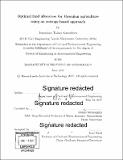Optimal land allocation for Hawaiian agriculture using an entropy-based approach
Author(s)
Kaneshiro, Jonathan Takao
DownloadFull printable version (16.23Mb)
Other Contributors
Massachusetts Institute of Technology. Department of Civil and Environmental Engineering.
Advisor
Dennis McLaughlin.
Terms of use
Metadata
Show full item recordAbstract
For over 50 years in The State of Hawai'i, the issues of food self sufficiency and environmental resource protection have been called for, but not necessarily addressed in a quantitative manner. These concerns have been key priorities in The State of Hawai'i Constitution, Hawai'i 2050 Sustainability Plan, Hawai'i County Development Plan and various Community Development Plans. As Hawaiian agriculture transitions from industrial mono-cropping plantation landscapes to small stakeholder farms, it is more important than ever to challenge these issues in the most efficient and sustainable way that is conscious of both environmental resources and resident values. This thesis aims to quantitatively allocate land and environmental resources using a representative entropy-based optimization model, which is formulated to maintain biodiversity while maximizing food self-sufficiency. Rigorous methods to quantify biophysical, water and land resources are implemented to ensure a robust output of optimal cropping areas on a pixel basis. Tradeoff curves are generated comparing fractions of land needed for agricultural expansion, self-sufficient population in fruits and vegetables and total entropy of Hawai'i Island. Results show that Hawai'i Island could sustain up to 6M people in fruits and vegetables, while maintaining the highest spatial heterogeneity and biodiversity. The high populations, however, should be assessed with regard to the cropping land expansions and changes in landscape, as these tradeoffs may outweigh the benefits.
Description
Thesis: M. Eng., Massachusetts Institute of Technology, Department of Civil and Environmental Engineering, 2017. Cataloged from PDF version of thesis. Includes bibliographical references (pages 105-110).
Date issued
2017Department
Massachusetts Institute of Technology. Department of Civil and Environmental EngineeringPublisher
Massachusetts Institute of Technology
Keywords
Civil and Environmental Engineering.